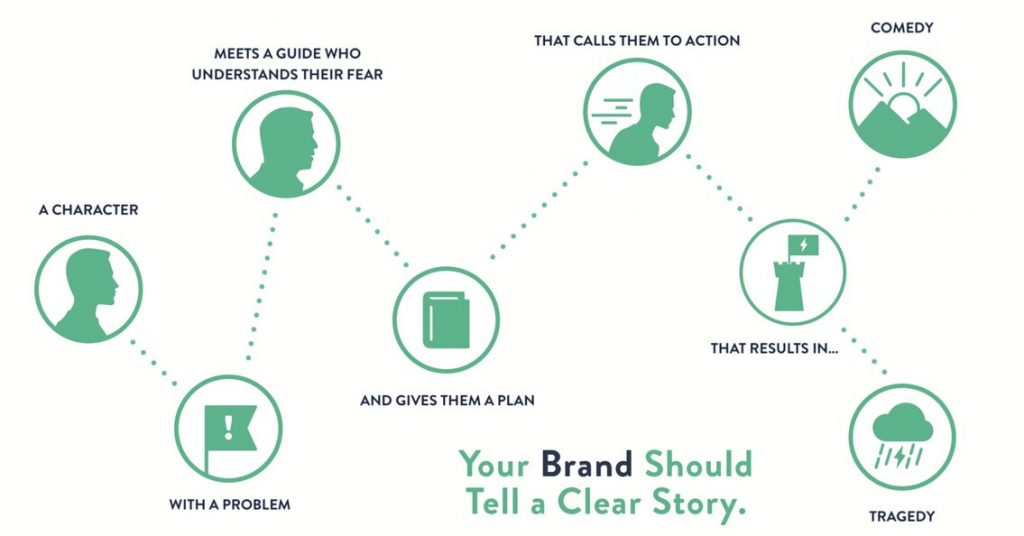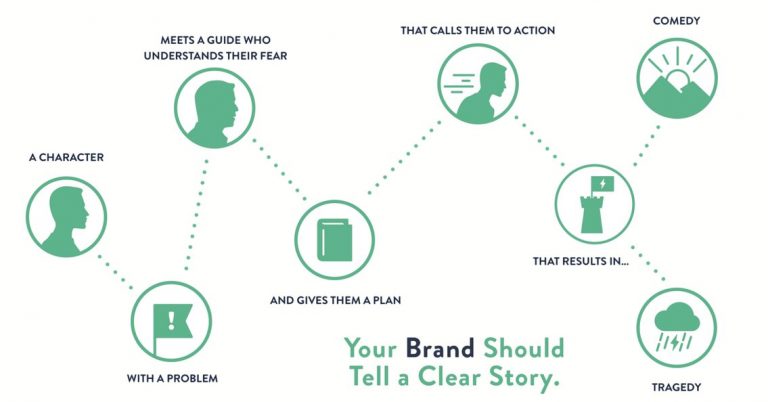In his book Building a StoryBrand, American author and public speaker Donald Miller presents the StoryBrand 7 Part Framework inspired by principles of storytelling. The SB7 Framework is a seven-step formula designed to help businesses streamline their marketing strategy by clarifying their message. With the SB7 Framework, you have the power to eliminate confusion, connect with customers, and grow your business.
“Think of the StoryBrand Framework as a recipe for a loaf of bread. Failure is like salt: use too much and you’ll ruin the flavor; leave it out and the recipe will taste bland. Regardless, the point is this: your story needs stakes.”
The StoryBrand 7 Part Framework is based on the hero journey which can be seen in most stories(movies)
- Every story starts with a character who wants something.
- A problem gets in the way of the character getting what they want.
- The character encounters a guide who can help them overcome their problem and get what they want.
- The guide gives the character a plan
- Calls them to action.
- By taking that action, the character avoids failure and
- Helps them achieve success

Here is a nutshell of the StoryBrand Framework by Donald Miller:
1. A Character
STORYBRAND PRINCIPLE ONE: THE CUSTOMER IS THE HERO, NOT YOUR BRAND.
A major paradigm shift in the SB7 Framework is that the customer is the hero of the story, not your brand. When we position our customer as the hero and ourselves as the guide, we will be recognized as a trusted resource to help them overcome their challenges.
Once we identify who our customer is, we have to ask ourselves what they want as it relates to our brand. The catalyst for any story is that the hero wants something. The rest of the story is a journey about discovering whether the hero will get what they want.
Unless we identify something our customer wants, they will never feel invited into the story we are telling.
A story doesn’t really pick up until the hero needs to disarm a bomb, win someone’s heart, defeat a villain, or fight for their emotional or physical survival. A story starts with a hero who wants something. And then the question becomes: Will the hero get
As a brand it’s important to define something your customer wants, because as soon as we define something our customer wants, we posit a story question in the mind of the customer: Can this brand really help me get what I want?
2. Has a Problem
STORYBRAND PRINCIPLE TWO: COMPANIES TEND TO SELL SOLUTIONS TO EXTERNAL PROBLEMS, BUT CUSTOMERS BUY SOLUTIONS TO INTERNAL PROBLEMS.
Once we identify who our customer is, we have to ask ourselves what they want as it relates to our brand. The catalyst for any story is that the hero wants something. The rest of the story is a journey about discovering whether the hero will get what they want.
Unless we identify something our customer wants, they will never feel invited into the story we are telling.
Identifying our customers’ problems deepens their interest in the story we are telling. Every story is about somebody who is trying to solve a problem, so when we identify our customers’ problems, they recognize us as a brand that understands them.
The problem is the “hook” of a story, and if we don’t identify our customers’ problems, the story we are telling will fall flat. As soon as the conflict in a story is resolved, audiences stop paying attention.
“The more we talk about the problems our customers experience, the more interest they will have in our brand.”
3. And Meets a Guide
STORYBRAND PRINCIPLE THREE: CUSTOMERS AREN’T LOOKING FOR ANOTHER HERO; THEY’RE LOOKING FOR A GUIDE
When a brand comes along and positions itself as the hero, customers remain distant. They hear us talking about how great our business is and start wondering if we’re competing with them for scarce resources. Their subconscious thought pattern goes like this: Oh, this is another hero, like me. I wish I had more time to hear their story, but right now I’m busy looking for a guide.
“The fatal mistake some brands make, especially young brands who believe they need to prove themselves, is they position themselves as the hero in the story instead of the guide”
Always position your customer as the hero and your brand as the guide. Always. If you don’t, you will die. When we empathize with our customers’ dilemma, we create a bond of trust. People trust those who understand them, and they trust brands that understand them too.
4. Who Gives Them a Plan
STORYBRAND PRINCIPLE FOUR: CUSTOMERS TRUST A GUIDE WHO HAS A PLAN.
Making a purchase is a huge step, especially if our products or services are expensive. What customers are looking for, then, is a clear path we’ve laid out that takes away any confusion they might have about how to do business with us.
In almost every story, the guide gives the hero a plan, or a bit of information, or a few steps they can use to get the job done. People are looking for a philosophy they can embody or a series of steps they can take to solve their problems.
When a customer places an order, they’re essentially saying, “I believe you can help me solve my problem, and I believe it so much I’m willing to put skin in the game. I’m willing to part with my hard-earned dollars.
Plans can take many shapes and forms, but all effective plans do one of two things: they either clarify how somebody can do business with us, or they remove the sense of risk somebody might have if they’re considering investing in our products or services.
5. And Calls Them to Action
STORYBRAND PRINCIPLE FIVE: CUSTOMERS DO NOT TAKE ACTION UNLESS THEY ARE CHALLENGED TO TAKE ACTION.
In stories, characters don’t take action on their own. They must be challenged. If we’re telling a story about a man who needs to lose thirty pounds and suddenly decides to do it of his own volition, the audience will check out. Why? Because that’s not how life works. There needs to be a reason.
This principle is true in story because it’s true in life. Human beings take action when their story challenges them to do so.
The reason characters have to be challenged to take action is because everybody sitting in the dark theater knows human beings do not make major life decisions unless something challenges them to do so.
Your customers are bombarded with more than three thousand commercial messages per day, and unless we are bold in our calls to action, we will be ignored. If our calls to action are soft, they will not be noticed.
Remember, people are drawn to clarity and away from confusion. Having clear calls to action means customers aren’t confused about the actions they need to take to do business with you.
6. That Helps Them Avoid Failure
STORYBRAND PRINCIPLE SIX: EVERY HUMAN BEING IS TRYING TO AVOID A TRAGIC ENDING.
If there is nothing at stake in a story, there is no story. Likewise, if there’s nothing at stake in whether or not I buy your product, I’m not going to buy your product. After all, why should I? Simply put, we must show people the cost of not doing business with us.
Stories live and die on a single question: What’s at stake? If nothing can be gained or lost, nobody cares.
Brands that help customers avoid some kind of negativity in life (and let their customers know what that negativity is) engage customers for the same reason good stories captivate an audience: they define what’s at stake.
The only two motivations a hero has in a story are to escape something bad or experience something good. Such is life. Our desire to avoid pain motivates us to seek a resolution to our problems.
If a storyteller doesn’t clearly let an audience know what no-good, terrible, awful thing might befall their hero unless she overcomes her challenge, the story will have no stakes, and a story without stakes is boring.
7. And Ends in a Success
STORYBRAND PRINCIPLE SEVEN: NEVER ASSUME PEOPLE UNDERSTAND HOW YOUR BRAND CAN CHANGE THEIR LIVES. TELL THEM
We must tell our customers how great their life can look if they buy our products and services. Everybody wants to be taken somewhere. If we don’t tell people where we’re taking them, they’ll engage another brand.
Nobody gets excited about a muddled vision. Stories aren’t vague, they’re defined; they’re about specific things happening to specific people. Otherwise they’re not stories; they’re just lofty notions
“In a good story, the resolution must be clearly defined so the audience knows exactly what to hope for.”

Brandscript
The StoryBrand Brandscript is a free digital application that helps you build and clarify your message using the seven-part framework. Visit the official webpage of the Brandscript app: https://www.mystorybrand.com/
All the Best in your quest to get Better. Don’t Settle: Live with Passion.



Comments are closed.